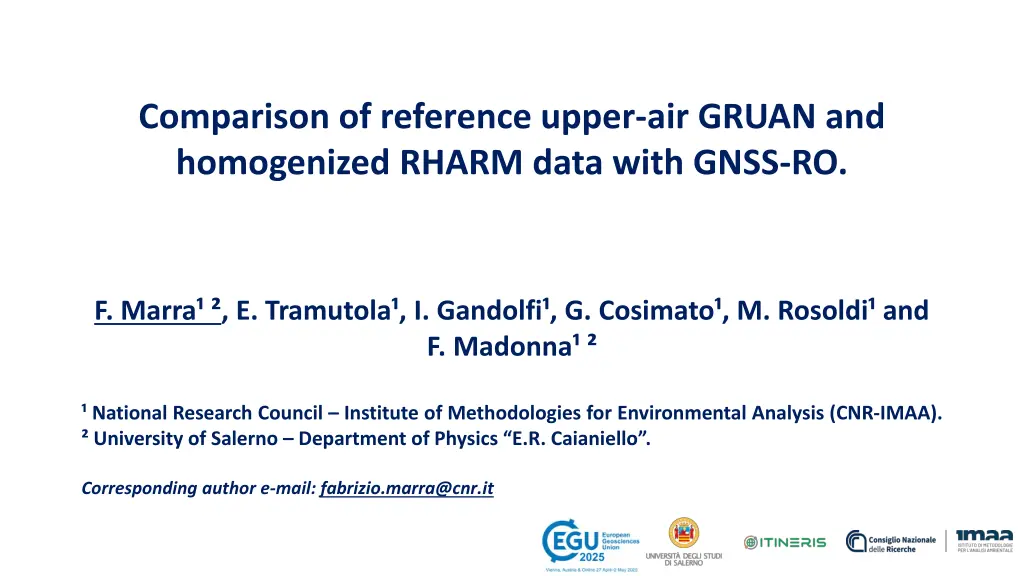
Comparison of Upper-Air Data: GNSS-RO vs GRUAN and RHARM
Explore the comparison of upper-air data from GRUAN, RHARM, and GNSS-RO, evaluating biases and accuracies in temperature and humidity profiles. RHARM shows good agreement with GRUAN, while GNSS-RO data exhibit biases in various regions. Discover the detailed results and methodologies in this insightful study.
Download Presentation

Please find below an Image/Link to download the presentation.
The content on the website is provided AS IS for your information and personal use only. It may not be sold, licensed, or shared on other websites without obtaining consent from the author. If you encounter any issues during the download, it is possible that the publisher has removed the file from their server.
You are allowed to download the files provided on this website for personal or commercial use, subject to the condition that they are used lawfully. All files are the property of their respective owners.
The content on the website is provided AS IS for your information and personal use only. It may not be sold, licensed, or shared on other websites without obtaining consent from the author.
E N D
Presentation Transcript
Comparison of reference upper-air GRUAN and homogenized RHARM data with GNSS-RO. F. Marra , E. Tramutola , I. Gandolfi , G. Cosimato , M. Rosoldi and F. Madonna National Research Council Institute of Methodologies for Environmental Analysis (CNR-IMAA). University of Salerno Department of Physics E.R. Caianiello . Corresponding author e-mail: fabrizio.marra@cnr.it
Objective Compare data from spatially complete global upper-air measurements with: GCOS Upper-Air Reference Network evaluating the accuracy of a novel bias-adjustment algorithm for temperature profiles; Global Navigation Satellite Systems - Radio Occultation (GNSS-RO) to assess performances of GNSS-RO temperature profiles in the UT/LS and relative humidity profiles. (GRUAN, www.gruan.org), for For the comparison, data from the Integrated Global Radio Sounding Archive (IGRA), available from NOAA NCEI and the bias-adjusted Radiosounding HARMonization (RHARM) dataset, available from Copernicus Data Store (https://cds.climate.copernicus.eu/cdsapp#!/dataset/insitu-observations-igra- baseline-network?tab=overview), are considered.
Main Results RHARM bias-adjusted upper-air data shows a good agreement with GRUAN, with differences up to 0.1 K, lower than IGRA, with differences up to 0.25 K. GNNS-RO data have been compared with RHARM data at a subset of 100 RHARM stations (longest data records), showing a bias, for temperature and relative humidity, in the Upper Troposphere/Lower Stratosphere (UT/LS) up to: 0.15 K and 9% in the Northern Hemisphere mid-latitudes (NH, 25 N-60 N). 0.25 K and 6% at the Northern Hemisphere polar latitudes (NP, 60 N-90 N). 0.3 K and 10% in the Tropics (TR, 25 S-25 N). Comparison of GNSS-RO with IGRA shows a bias up to 0.1 K and 6% in the NH, up to 0.2 K and 6% in the NP and up to 0.3 K and 12% in the TR. GNSS-RO is closer to IGRA, while GRUAN is closer to RHARM.
For more information, we invite you to explore PICO5.14. Acknowledgments: This work was supported by IR0000032 ITINERIS, Italian Integrated Environmental Research Infrastructures System (D.D. n. 130/2022 - CUP B53C22002150006) Funded by EU - Next Generation EU PNRR- Mission 4 Education and Research - Component 2: From research to business - Investment 3.1: Fund for the realisation of an integrated system of research and innovation infrastructures






















